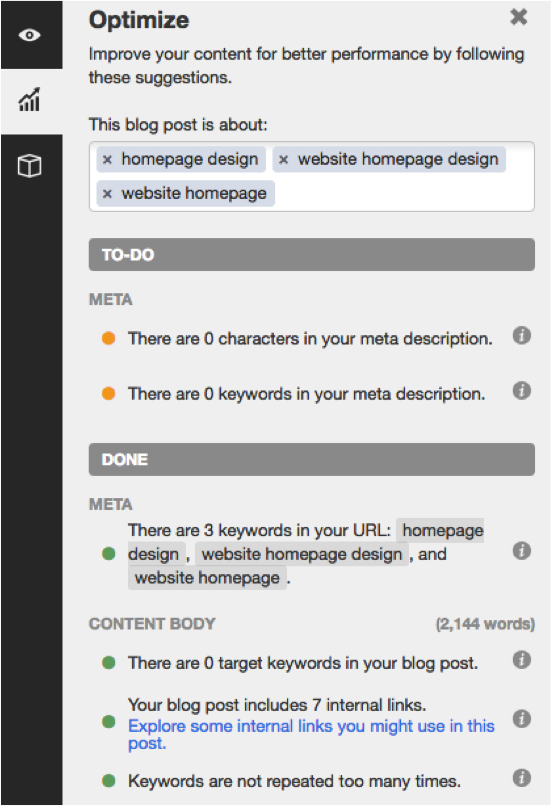10 Blog SEO Tips to Search Engine Optimize Your Blog Content 1. Optimizing your blog posts for keywords is not about incorporating as many keywords into your posts as possible. Why long-tail keywords? Whenever you create content, your primary focus should be on what matters to your audience, not how many times you can include a keyword or keyword phrase in that content. Your meta description is meant to give search engines and readers information about your blog post's content -- so be certain to use your long-tail term so Google and your audience are clear on your post's content. As you can see in the above image, Google pulls in other parts of your blog post that includes the keywords searched, presumably to give searchers optimal context around how the result matches their specific query. But search engines don't just look for images. For example, topic tags like "blogging," "blog," and "blog posts" are too similar to one another to be used on the same post. If you've written about a topic that's mentioned in your blog post on another blog post, ebook, or web page, it's a best practice to link to that page. The way most blogs are currently structured (including our own blogs, until very recently), bloggers and SEOs have worked to create individual blog posts that rank for specific keywords.

Does Blogging Help With SEO?
Blogging helps boost SEO quality by positioning your website as a relevant answer to your customers’ questions. Blog posts that specifically use a variety of on-page SEO tactics can give you more opportunities to rank in search engines and get customers to visit your site.
Search engine optimization is incredibly important for marketers. When you optimize your web pages — including your blog posts — you’re making your website more visible to people who are entering keywords associated with your product or service via search engines like Google.
But Google’s copious algorithm updates make this tricky. And today’s SEO best practices are all about relevancy and intent. Keep reading — I’ll explain.
How do you know what matters and what doesn’t? What are today’s blog ranking tactics, and what’s considered “old-school”? How on Earth can you keep it all straight?
Confusion is a common issue facing digital content marketers — and we want to help. In this post, we’ll cover how to optimize your blog posts for the keywords you care about, along with a few other optimization tactics you should keep in mind.
Note that this list doesn’t cover every single rule under the sun. Rather, the following 10 SEO tips are the on-page factors to get you started with an SEO strategy for your blog in particular.
SEO can be confusing. Listen as HubSpot’s own Matt Barby and Victor Pan clear things up:
HubSpot customers: If you want to see specific SEO optimization tips for your individual blog posts, click the bar graph icon on the far left side of the blog editor when you’re working on the post to access the SEO Optimization screen.

If you’re not a customer, you can use these tips as a checklist as you blog.
(Want to learn more about content creation, strategy, and promotion? Sign up here to take our free Content Marketing Certification course.)
10 Blog SEO Tips to Search Engine Optimize Your Blog Content
1. Focus on 1–2 long-tail keywords that match the intent of your ideal reader.
Optimizing your blog posts for keywords is not about incorporating as many keywords into your posts as possible. Nowadays, this actually hurts your SEO because search engines consider this keyword stuffing (i.e., including keywords as much as possible with the sole purpose of ranking highly in organic search).
It also doesn’t make for a good reader experience — a ranking factor that search engines now prioritize to ensure you’re answering the intent of your visitors. Therefore, you should use keywords in your content in a way that doesn’t feel unnatural or forced.
A good rule of thumb is to focus on one or two long-tail keywords per blog post. While you can use more than one keyword in a single post, keep the focus of the post narrow enough to allow you to spend time actually optimizing for just one or two keywords.
Why long-tail keywords? These longer, often question-based keywords keep your post focused on the specific goals of your audience. Website visitors searching long-tail terms are more likely to read the whole post and then seek more information from you. In other words, you’ll generate right type of traffic: visitors who convert.
2. Include these 1–2 keywords in specific parts of your post.
Now that you’ve got your one or two keywords, it’s time to incorporate them into your blog post. Where are the best parts of your posts to include these terms so you rank high in search results?
There are four essential places where you should try to include your keywords: title tag, headers & body, URL, and meta description.
The title (i.e., headline) of your blog post will be a search engine’s and reader’s first step in determining the relevancy of your content, so including a keyword here is vital. Google calls this the “title tag” in a search result.
Be sure to include your keyword within the first 60 characters of your title, which is just about where Google cuts titles off on search engine results pages (SERPs). Technically, Google measures by pixel width, not character count, and it recently increased the pixel width for organic search results from approximately 500 pixels to 600 pixels, which translates to around 60 characters.
Long title tag? When you have a lengthy headline, it’s a good idea to get your keyword in the beginning since it might get cut off in SERPs toward the end, which can take a toll on your post’s perceived relevancy. In the example below, we had a long title that went over 65 characters, so we front-loaded it with the keyword for which we were trying to rank: “on-page SEO.”

Mention your keyword at a normal cadence throughout the body of your post and in the headers. That means including your keywords in your copy, but only in a natural, reader-friendly way. Don’t go overboard at the risk of being penalized for keyword stuffing. Before you start writing a new blog post, you’ll probably think about how to incorporate your keywords into your post. That’s a smart idea, but it shouldn’t be your only focus, nor even your primary focus.
Whenever you create content, your primary focus should be on what matters to your audience, not how many times you can include a keyword or keyword phrase in that content. Focus on being helpful and answering whatever question your customer might’ve asked to arrive on your post. Do that, and you’ll usually find you naturally optimize for important keywords, anyway.
Search engines also look to your URL to figure out what your post is about, and it’s one of the first things it’ll crawl on a page. You have a huge opportunity to optimize your URLs on every post you publish, as every post lives on its own unique URL — so make sure you include your one to two keywords in it.
In the example below, we created the URL using the long-tail keyword for which we were trying to rank: “email marketing examples.”

Later in this post, we’ll dive into meta descriptions a bit more. Your meta description is meant to give search engines and readers information about your blog post’s content — so be certain to use your long-tail term so Google and your audience are clear on your post’s content.
At the same time, keep in mind the copy matters a great deal for click-through rates because it satisfies certain readers’ intent. The more engaging, the better.
3. Make sure your blog is mobile-friendly.
Did you know more people use a search engine from their mobile phones than from a computer?
And for all those valuable search queries being done on mobile, Google displays the mobile-friendly results first. This is yet another example of Google heavily favoring mobile-friendly websites — which has been true ever since the company updated its Penguin algorithm in April 2015.
(HubSpot customers: Breathe easy. All content created on HubSpot’s platform is automatically responsive to mobile devices.)
So, how do you make your blog mobile-friendly? By using “responsive design.” Websites that are responsive to mobile allow blog pages to have just one URL instead of two — one for desktop and one for mobile, respectively. This helps your post’s SEO because any inbound links that come back to your site won’t be divided between the separate URLs.
As a result, you’ll centralize the SEO power you gain from these links, helping Google more easily recognize your post’s value and rank it accordingly.
…

COMMENTS